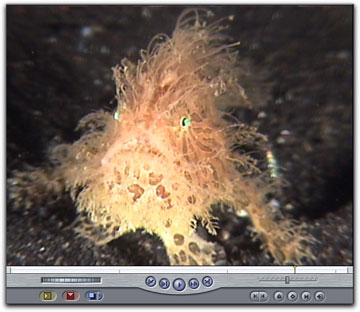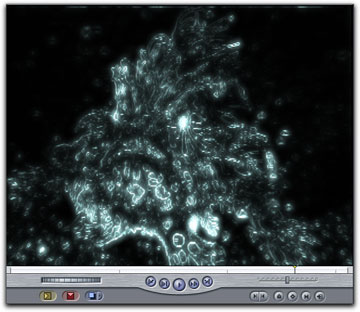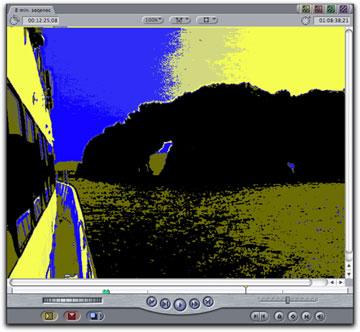I had a ball thinking of ways to use the P-Xray filter which
utilizes a few of the same inner workings as the Anarchist Edge
filter but provides the ability to invert the results with the
glow similar to a real X-ray projector.

Here we have the original,
a Frog Fish from Indonesia |

For those old enough to
remember, we now have the original
monster from "Forbidden Planet". It used to give me
nightmares,
how did I know they borrowed this from Digital Anarchy? |
The P-Anarchist Edge Filter was another standout filter that
worked well in several editing creations. It is a shame that
you cannot see the key framing possibilities rather than these
screen grabs, but this filter can go a long ways in a sequence.
The
original and final clips
From
Buddist Temple to something out of Ray Harryhausen's '7th Voyage
of Sinbad'
The P-Bubblewrap filter was just as interesting to me. It has
controls for the displacement and size of the bubbles, as well
as for the amount of contrast that is desired. I applied it to
a frame of a cuttlefish for this appropriately watery effect.
The P-Expose filter enabled me to make a dramatic improvement
over the original exposure of this clip. The deepened blacks
and stronger contrast makes for a more powerful image.
Improving
the overall exposure and the intensity in the blacks makes for
and obvious quality difference.
From the original frame of the boat approaching Darwin Island
in the Galapagos, the Plasma Poster Art does just that, creates
an easy to apply, artistic representation. In my case, a Peter
Max pop art.

I thoroughly enjoyed what I could do
with the P-Impasto filter which creates an almost 3D image, while
the Plasma FX 1.0's Old Film's default settings alone did the
trick.
The many other filters here were all
quite excellent, providing image wells for backgrounds and composite
mode settings for a milieu of final results as well as the normal
number of standard parameter adjustments. Other filters not shown
here are the Technicolor 2 &3-pass filters, Gradient Funhouse,
Ink on Glass, Light Burst, Poster Art, Quicksilver, Swelter,
Temp Blend and Temperature filters, Bleach Bypass, Explode, Edge
Rays and Enhance filters, Defocus, Duo Toner, Colorized Bloom,
Cartoon Effects, and Active Solarize filter.
One of these days I will need to purchase
one of the newer, more powerful Macs. I certainly haven't noticed
any companies sending one to me gratis. However, even with this
2-year-old DP 2GHZ G5, 2gigs of ram and a Radeon 9800 Pro graphics
card, rendering of a 16 sec clip and the Ink on Glass Filter
took a reasonable 1min, 11 seconds to complete.
I have always made it a point to mention
a company's website and whether or not free tutorials were available
to the purchaser who might not know how to achieve the same effects
advertised and demonstrated by the company themselves. Having
a tool and not having any idea how to use it is like not having
it at all. Digital Anarchy has always provided excellent tutorials
for their many plug-in packages. While ones for this new Plasma
FX set are not up on their site yet, I am confident that they
soon will be.
Thus, my bottom line for Digital Anarchy's
Plasma FX plug-ins package is that you just will not go wrong
with its purchase. I had no complaints with their use or application.
The plug-ins were rock steady, produced quality results and are
surprisingly inexpensive. Even more important is that this set
of 26 Plasma FX plug-ins is a collection that you will actually
use in probably quite a few productions.
 Steve Douglas is an underwater
videographer and contributor to numerous film festivals around
the world. A winner of the 1999 Pacific Coast Underwater Film
Competition, 2003 IVIE competition, 2004 Los Angeles Underwater
Photographic competition, and the prestigious 2005 International
Beneath the Sea Film Competition, where he also won the Stan
Waterman Award for Excellence in Underwater Videography and 'Diver
of the Year', Steve was a safety diver on the feature film "The
Deep Blue Sea", contributed footage to the Seaworld Park's
Atlantis production, and a recent History channel MegaDisaster
show. Steve is one of the founding organizers of the San Diego
UnderSea Film Exhibition and leads both underwater filming expeditions
and African safaris with upcoming excursions to Kenya, Bali &
Komodo in 2007, and Costa Rica and Palau in 2008. Feel free to
contact him if you are interested in joining Steve on any of
these exciting trips. www.worldfilmsandtravel.com
Steve Douglas is an underwater
videographer and contributor to numerous film festivals around
the world. A winner of the 1999 Pacific Coast Underwater Film
Competition, 2003 IVIE competition, 2004 Los Angeles Underwater
Photographic competition, and the prestigious 2005 International
Beneath the Sea Film Competition, where he also won the Stan
Waterman Award for Excellence in Underwater Videography and 'Diver
of the Year', Steve was a safety diver on the feature film "The
Deep Blue Sea", contributed footage to the Seaworld Park's
Atlantis production, and a recent History channel MegaDisaster
show. Steve is one of the founding organizers of the San Diego
UnderSea Film Exhibition and leads both underwater filming expeditions
and African safaris with upcoming excursions to Kenya, Bali &
Komodo in 2007, and Costa Rica and Palau in 2008. Feel free to
contact him if you are interested in joining Steve on any of
these exciting trips. www.worldfilmsandtravel.com
copyright © Steve
Douglas 2007
This article first appeared
on www.kenstone.net and
is reprinted here with permission.
All screen captures and textual references are the property and
trademark of their creators/owners/publishers.